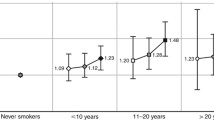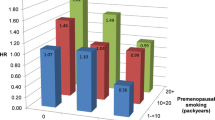Abstract
Objective: An earlier investigation reported a five-fold increase in breast cancer risk among women who smoked during pregnancy. Using a similar design, we re-examined this hypothesis. Methods: The source population comprised Massachusetts residents who gave birth between 1987 and 1999 with a birth record in the Massachusetts Vital Statistics Registry. Cases were diagnosed with breast cancer between 1988 and 2000 at ages 25–55 with a record in the Massachusetts Cancer Registry. Three controls were matched to each case on maternal age, year of giving birth, and birth facility. Information on smoking, the matched factors, and potential confounders were collected from the birth certificate. The data were analyzed using conditional logistic regression. Results: After adjusting for potential confounders, women who smoked during pregnancy did not have an increased risk of breast cancer compared to women who did not smoke during pregnancy (relative risk = 1.0, 95% Confidence interval CI = 0.81–1.2). We observed no dose response relation between number of cigarettes smoked per day during pregnancy and breast cancer risk. There was no evidence that our results were biased by misclassification from women inaccurately reporting their smoking status. Conclusion: In contrast to the previous study, we did not observe an increased risk of breast cancer in women who smoked during pregnancy.
Similar content being viewed by others
References
Terry PD, Rohan TE (2002) Cigarette smoking and the risk of breast cancer in women: a review of the literature. Cancer Epidemiol, Biomarkers Prev 11: 953-971.
Pawlega J (1992) Breast cancer and smoking, vodka drinking and dietary habits: a case control study. Acta Oncologica 31(4): 387-392.
Palmer JR, Rosenberg L (1993) Cigarette smoking and the risk of breast cancer. Epidemiol Rev 15(1): 145-156.
Engeland A, Andersen A, Haldorsen T, Steiner T (1996) Smoking habits and risks of cancers other than lung cancer: 28 years' follow-up of 26,000 Norweigian men and women. Cancer Causes Controls 7: 497-506.
Morabia A, Bernstein M (2000) A review of the relation of active and passive smoking to breast cancer. J Women Cancer 2(1): 1-9.
Manjer J, Berglund G, Bondesson L, Garne JP, Janzon L, Malina J (2000) Breast cancer incidence in relation to smoking cessation. Breast Cancer Res Treat 61(2): 121-129.
Terry PD, Miller AB, Rohan TE (2000) Cigarette smoking and breast cancer risk: A long latency period? Int J Cancer 100: 723-728.
Russo J, Hu Y-H, Yang X, Russo IH (2000) Developmental, cellular and molecular basis of human breast cancer. J National Cancer Inst Monographs 27: 17-37.
Pike MC, Spicer DV, Dahmoush L, Press M (1993) Estrogens, progestogens, normal breast cell proliferation, and breast cancer risk. Epidemiol Rev 15(1): 17-35.
Tokunaga M, Land CE, Tokuoka S, Nishimori I, Soday M, Akiba S (1994) Incidence of female breast cancer among atomic bomb survivors, 1950-1985. Radiation Res 138: 209-223.
Aisenberg AC, Finkelstein DM, Dopke KP, Koerner FC, Boivin JF, Willet CG (1997) High risk of breast carcinoma after irradiation of young women with hodgkin's disease. Cancer 79(6): 1203-1210.
Hoffman DA, Lonstein JE, Morin MM, Visscher W, Harris BSHI, Boice JD Jr (1989) Breast Cancer in Women with Scoliosis exposed to multiple diagnostic X Rays. J National Cancer Inst 81: 1307-1312.
Land CE, Hayakawa N, Machado SG, et al. (1994) A case-control interview study of breast cancer among Japanese A-bomb survivors: interactions with radiation dose. Cancer Causes Control 5: 167-176.
Lash TL, Aschengrau A (1999) Active and passive cigarette smoking and the occurrence of breast cancer. Am J Epidemiol 149(1): 5-12.
Band PR, Le ND, Fang R, Deschamps M (2002) Carcinogenic and endocrine disrupting effects of cigarette smoke and the risk of breast cancer. Lancet 360(9339): 1044-1049.
Adami H-O, Lund E, Bergstrom R, Meirik O (1988) Cigarette smoking, alcohol consumption and risk of breast cancer in young women. Br J Cancer 58: 832-837.
Egan KM, Stampfer MJ, Hunter DJ, et al. (2002) Active and passive smoking in breast cancer: Prospective results from the nurses' health study. Epidemiology 13(2): 138-145.
Lash TL, Aschengrau A (2002) A null association between active or passive cigarette smoking and breast cancer risk. Breast Cancer Res Treat 75: 181-184.
Kropp S, Chang-Claude J (2002) Active and passive smoking and the risk of breast cancer by age 50 among German women. Am J Epidemiol 156(7): 616-626.
London SJ, Colditz GA, Stampfer MJ, Willett WC, Rosner BA, Speizer FE (1989) Prospective study of smoking and the risk of breast cancer. J National Cancer Inst 81(21): 1625-1631.
Brinton LA, Schairer C, Stanford JL, Hoover RN (1986) Cigarette smoking and breast cancer. Am J Epidemiol 123(4): 614-622.
Field NA, Baptiste MS, Nasca P, Metzfer BB (1992) Cigarette smoking and breast cancer. Int J Epidemiol 21(5): 842-848.
Calle EE, Miracle-McMahill HL, Thun MJ, Heath CW (1994) Cigarette smoking and risk of fatal breast cancer. Am J Epidemiol 139(10): 1001-1007.
Wartenberg D, Calle EE, Thun MJ, Heath CW, Lally C, Woodruff T (2000) Passive smoking exposure and female breast cancer mortality. J National Cancer Inst 92(20): 1666-1673.
Johnson KC, Hu J, Mao Y (1999) The Canadian Cancer Registries Epidemiology Research Group. Passive and Active smoking and breast cancer risk in Canada, 1994-1997. Cancer Causes Control 11: 211-220.
Palmer JR, Rosenberg L, Clarke A, et al. (1991) Breast cancer and cigarette smoking: a hypothesis. Am J Epidemiol 134(1): 1-13.
Ambrosone CB, Freudenheim JL, Graham S, et al. (1996) Cigarette smoking, N-acetyltransferase 2 genetic polymorphisms, and breast cancer risk. J Am Med Assoc 276(18): 1494-1501.
Innes KE, Byers TE (2001) Smoking during pregnancy and breast cancer risk in very young women. Cancer Causes Control 12(2): 179-185.
Colditz GA, Frazier AL (1995) Models of breast cancer show that risk is set by events of early life: prevention efforts must shift focus. Cancer Epidemiol Biomarker Prev 4: 567-571.
Malmstadt JR, Nordstrom DL, Christiansen AL, Chudy NE, Rumm PD, Remington PL (2001) Cigarette smoking in Wisconsin: the influence of race, ethnicity and socioeconomics. Wisconsin Med J 100(3): 29-33.
Heck KE, Pamuk ER (1997) Explaining the relation between education and postmenopausal breast cancer. Am J Epidemiol 145(4): 366-372.
Baquet CR, Commiskey P (2000) Socioeconomic factors and breast carcinoma in multicultural women. Cancer 88(Suppl 5): 1256-1264.
Borman B, Wilson N, Mailing C (1999) Socio-demographic characteristics of New Zealand smokers: results from the 1996 census. New Zealand Med J 112(1101): 460-463.
Kelsey JL, Gammon MD, John EM (1993) Reproductive factors and breast cancer. Epidemiol Rev 15(1): 36-47.
Ness RB, Grisso JA, Hirschinger N, et al. (1999) Cocaine and tobacco use and the risk of spontaneous abortion. New England J Med 340(5): 333-339.
Kitamura T, Toda MA, Shima S, Sugawara M (1998) Single and repeated elective abortions: a psychosocial study. J Psychosomatic Obsterics Gynecol 19(3): 126-134.
Tang M-TC, Weiss NS, Malone KE (2000) Induced abortion in relation to breast cancer among parous women: a birth certificate registry study. Epidemiology 11(2): 177-180.
Rothman KJ, Greenland S. Modern Epidemiology. 2nd edn. Philadelphia: Lippincott-Raven, 1998
Dietz PM, Adams MM, Kendrick JS, Mathis MP, the PRAMS Working Group (1998) Completeness of ascertainment of prenatal smoking using birth certificates and confidential questionnaires: variations by maternal attributes and infant birth weight. Am J Epidemiol 148(11): 1048-1054.
Piper JM, Mitchel EF Jr, Snowden M, Hall C, Adams M, Taylor P (1993) Validation of 1989 Tennessee birth certificates using maternal and newborn hospital records. Am J Epidemiol 137 (7): 758-768.
Buescher PA, Taylor KP, Davis MH, Bowling JM (1993) The quality of the new birth certificate data: a validation study in North Carolina. Am J Public Health 83(8): 1163-1165.
Greenland S, Schwartzbaum JA, Finkle WD (2000) Problems due to small samples and sparse data in conditional logistic regression. Am J Epidemiol 151(5): 531-539.
Peduzzi P, Concato J, Kemper E, Holford TR, Feinstein AR (1996) A simulation study of the number of events per variable in logistic regression analysis. J Clin Epidemiol 49(12): 1373-1379.
Eriksson KM, Haug K, Salvesen KA, et al. (1998) Smoking habits among pregnant women in Norway 1994-95. Acta Obstetricia et Gynecologica Scandinavica 77(2): 159-164.
Hakansson A, Lendahls L, Petersson C (1999) Which women stop smoking? A population-based study of 403 pregnant smokers. Acta Obstetricia et Gynecologica Scandinavica 78: 217-224.
Collaborative Group on Hormonal Factors in Breast Cancer (2002) Alcohol, tobacco and breast cancer-collaborative reanalysis of individual data from 53 epidemiological studies, including 58, 515 women with breast cancer and 95,067 women without the disease. Brit J Cancer 87: 1234-1245.
Author information
Authors and Affiliations
Corresponding author
Rights and permissions
About this article
Cite this article
Fink, A.K., Lash, T.L. A null association between smoking during pregnancy and breast cancer using Massachusetts registry data (United States). Cancer Causes Control 14, 497–503 (2003). https://doi.org/10.1023/A:1024922824237
Issue Date:
DOI: https://doi.org/10.1023/A:1024922824237




